Introduction
Suzanne Wold-Burkness and W.D. Hutchison
Department of Entomology, University of Minnesota
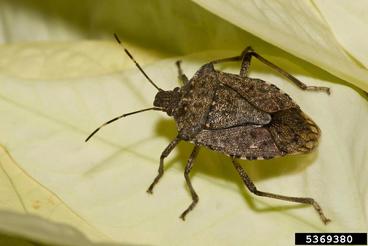
The brown marmorated stink bug (BMSB), Halyomorpha halys (Fig. 1), is an invasive insect that was first found in Pennsylvania in 1996 (Hoebeke & Carter 2003). It has since spread across most of the U.S. and has reached pest status in 10 states in the eastern U.S. (Fig. 2). In Minnesota, BMSB was first found in 2010 in St. Paul, MN (Koch 2013), and we now have several pockets of reproducing populations near the Twin Cities. BMSB has a vast host range that currently includes 170 plants, but that number is expected to grow over time (Bergmann et al. 2015). Critical crops in the Midwest that could be impacted include apple, raspberry, sweet corn, green beans, wine grapes, soybean, as well as numerous species of shade and ornamental trees.
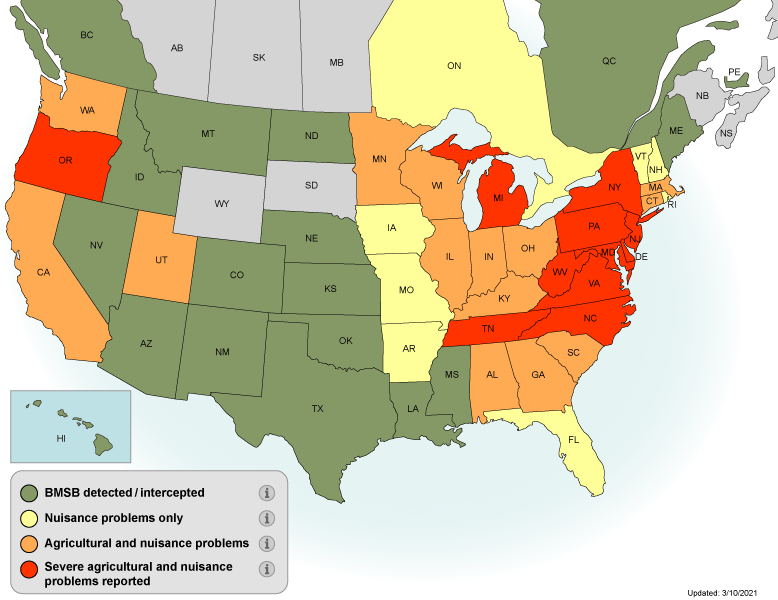
Biology
BMSB adults are ½ inch long, shield-shaped, and are marbled-brown color (Fig. 3). There are several native stink bug species that are similar in appearance, however, the following group of characteristics are specific to BMSB. The antennae are dark with light colored bands, there is an alternating dark-and-light pattern along the edges of the abdomen, the underside of the abdomen is light colored, and the shoulders are smooth and rounded.
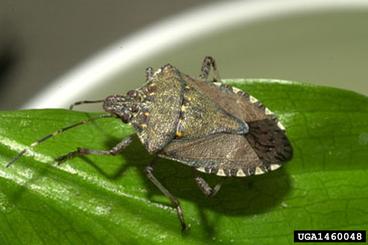

Adults emerge in mid to late spring from their overwintering areas in leaf litter near buildings. In Minnesota we have observed BMSB activity on the outside of structures as early as May 15. Approximately two weeks after emergence adults will mate and females begin laying eggs. Eggs are greenish-white colored, barrel shaped, and laid in clusters usually on the underside of leaves (Fig. 4). There are five nymphal stages that range in size from <0.25 cm (1st instar) to 1.25 cm (5th instar). First instar nymphs are brightly colored red-orange and black (Fig. 5). Later instars develop the marbled-brown color (Fig. 6). In the northeastern U.S., BMSB has only one generation/year.


Damage
BMSB feed on fruit, pods, buds, leaves, and stems using their piercing sucking mouthparts. Their feeding on fruit results in damage ranging in severity from a mild blemish to fruit that is severely malformed. In apples, the injury is amplified as the fruit matures, resulting in “cat-faced” apples (Fig. 7) and internal scarring of the fruit (Fig. 8), which ultimately renders the fruit unmarketable.
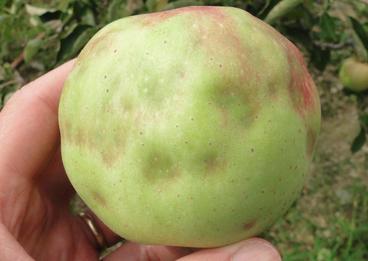
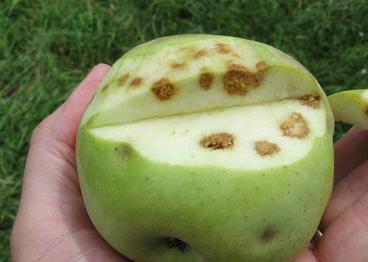

In wine grapes, BMSB feeding can cause the berry to soften and possibly become a pathway for a pathogen, however, what may be of more concern is the potential threat of BMSB contaminants. In the eastern U.S., adults and nymphs have been observed tucked into grape clusters as temperatures become cooler (Fig. 9). This creates the possibility of harvesting BMSB along with grape clusters. In the wine making process the chemicals released by BMSB would taint the wine, thus rendering it unmarketable.
References
Bergmann E., K.M. Bernhard, G. Bernon, M. Bickerton, S. Gill, C. Gonzales, G.C. Hamilton, C. Hedstrom, K. Kamminga, & C. Koplinka-Loehr et al. 2015. Host plants of the brown marmorated stink bug. http://www.stopbmsb.org/where-is-bmsb/host-plants
Cira, T.M., R.C. Venette, J. Aigner, T. Kuhar, D.E. Mullins, S.E. Gabbert, & W.D. Hutchison. 2016. Cold tolerance of Halyomorpha halys (Hemiptera: Pentatomidae) across geographic and temporal scales, Environ. Entomol. 45(2): 484–491.https://doi.org/10.1093/ee/nvv220
Hoebeke E.R. & M.E. Carter. 2003. Halyomorpha halys (Stål) (Heteroptera: Pentatomidae): a polyphagous plant pest from Asia newly detected in North America. Proc. Entomol. Soc. Washington . 105: 225–237.
Koch, R.L. 2014. Detections of the brown marmorated stink bug (Hemiptera: Pentatomidae) in Minnesota. J. Entomol. Sci. 49(3): 313-317.
Rice, K.B., C. J. Bergh, E.J. Bergmann, D.J. Biddinger, C. Dieckhoff, G. Dively, H. Fraser, T. Gariepy, G. Hamilton, T. Haye, A. Herbert, K. Hoelmer, C.R. Hooks, A. Jones, G. Krawczyk, T. Kuhar, et al. 2014. Biology, Ecology, and Management of Brown Marmorated Stink Bug (Hemiptera: Pentatomidae). J. Integrated Pest Mgt. 5(3): A1-A13. https://doi.org/10.1603/IPM14002
Revised April 2, 2021